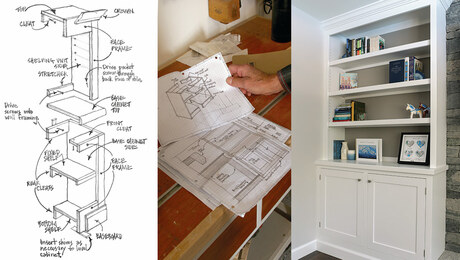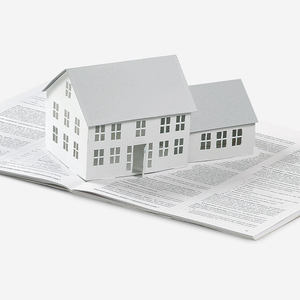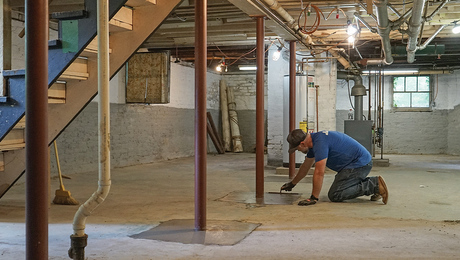12 Restoration Blunders
Don't let poor planning and unrealistic expectations destroy a great old house.

With obsolete systems and failing, sometimes unsafe structural components, old homes make for complex projects replete with pitfalls for unwary remodelers. As a restoration contractor, I feel like I’ve seen it all: homeowners who spend hundreds of thousands of dollars on renovations that commence with no planning, who devalue their property by stripping away its character, or who throw away money by forgoing valuable tax credits—in short, people who miss key opportunities in their attempt to restore their old house to its past glory while making it modern and efficient to live in. Here are blunders I’ve seen often in my work, with some advice on how to sidestep them.
Mistake 1: Proceeding without a plan
Old-home renovations often don’t go according to plan because too often, there is no planning. Homeowners question the need to duplicate existing conditions on paper and see the process as a waste. Why put money into plans, they ask, when what I want is tile and cabinetry? In addition, in older homes, there’s a tendency to jump into crisis management— repairing termite or foundation damage, for example—without pausing to assess future needs fully.
There’s also the persistent (and incorrect) assumption that tradespeople will conduct logical improvements in keeping with the scope of a project, even when that scope has never been spelled out fully. For example, HVAC subs like to put their systems in the path of least resistance—such as in the middle of a potentially finishable attic. If uninformed about future plans for that space, they’re unlikely to reach the “logical” conclusion of locating the air handler out of the way.
It’s simple: Planning and detailing the scope of every renovation in clear, specific terms is key to success.
Mistake 2: Expecting to “Flip”
One of the most common mistakes I’ve seen is an investor taking on an old home as a rehab-and-flip project. Glorified by many a TV show during the housing boom, the flip process usually involves minor cosmetic improvements—“carpet and paint” is the common upgrade—to a house that is purchased, rehabbed, and sold in as little as a month. Old homes simply take too long to flip. What’s more, they require far more thought, intuition, and planning than is common in the investor market.
If a home requires all new systems and major foundation work, the process may exceed a year and require a team of professionals to pull off. Also, inexpensive fixes common to flip jobs can inflict irreversible damage on a vintage home. The destructive nature of a vinylsiding job is just one example: Where architectural details are in the way, vinyl installers tend to destroy them.
Successful old-home projects take time; flips do not. The two are rarely compatible.
Mistake 3: Assuming an unrealstic budget
In old-house remodels, as in any project, costs must be managed, but no level of management can make an unrealistic budget realistic. While some remodelers take the complexities and vagaries of old homes as an excuse to work with no budget, I’d argue that this is a reason to spend more time making one that is professional, accurate, and performable.
At a local historic-home tour recently, a contractor suggested that you should add 40% to your budget to cover overages he didn’t think of. I find that unprofessional. Instead, work to create a real budget, and have it looked over by multiple experts: partners, other project managers, even other builders. Ask everyone what you are missing. The Construction Specifications Institute’s coding system is a good checklist; our scopes always follow this format.
Old homes add all the complexities of custom remodeling to all the complexities of dealing with environmental hazards, consulting outside experts, and matching nonstock materials and fittings. I’ve seen builders who focus on new construction grossly underbid old-home baseboard, bidding 4-in. MDF speed base when the job required custom 10-in. builtup molding. To be safe, I build in contingency allowances on the most unpredictable jobs.
If an experienced builder’s quotes look high at first glance, it may just reflect the little items often overlooked. That should mean there will be no surprises.
Mistake 4: Failing to coordinate your team
Coordination is commonly the job of a general contractor or architect, but many remodeling jobs have no GC or designer present, leaving the trades segregated. This can be particularly problematic in an old-house remodel.
Here’s one example: It’s a general rule in construction that the trade needing a penetration is responsible for making the penetration— that is, the plumber putting a waste line through a wall cuts the hole. That doesn’t always fly in old homes. Trades are skittish about cutting into plaster, which means their work has to be coordinated with carpenters.
In old homes especially, improvements to insulation, windows, and HVAC need to be addressed holistically. If the mechanical sub does not know that the house is spray-foamed and is getting storm windows, he will invariably oversize the equipment, making it more expensive to install and operate. The mechanical trades, and HVAC in particular, need to be on the same page. We spend the most time planning, specifying, and testing HVAC, which is the most complex system. It’s also the one where improper installations are not caught by inspectors, unlike plumbing and electrical systems. Because it involves a third-party inspection, Energy Star certification is our favorite tool to audit HVAC and envelope efficiencies. Energy raters almost always catch something the builder didn’t, making them valuable partners in quality control.
Mistake 5: Mishandling environmental hazards
Asbestos and lead paint are the two most common environmental dangers present in old homes. Asbestos, found in mastics, insulations, and tape, was used most extensively from the 1950s to the 1980s; lead-based paint was used most widely in houses built from the 1880s to the 1920s. While both hazards occur outside those ranges (lead paint was used until 1978), houses built during those time periods deserve heightened concern.
Asbestos and lead have the same three remediation options: Remove the hazard from the material it is adhered to; remove the entire material the hazard is adhered to; or encapsulate. In almost all scenarios, encapsulation is the best option.
Lead-paint mitigation has gotten heightened attention thanks to the EPA’s new Renovation, Repair, and Painting Rule, under which contractors who disturb painted surfaces in homes built before 1978 must be certified and follow specific work practices to prevent contamination. If you work on old homes frequently, you should become certified. If pre-1978 homes are the exception rather than the rule in your business, look for demolition and paint subs that are certified.
Lead tests are inexpensive and simple to use. There is no similarly quick asbestos test; suspect samples must be sent to a lab. Asbestos mitigation always should be handled by specialists.
Contrary to conventional wisdom, in many ways old homes have fewer environmental hazards than new homes. There are no formaldehydes or synthetics, and fewer glues and plasticizers. And mold—one of today’s leading home-health concerns—is almost never a problem in old homes, which often lack the drywall and insulation where it breeds.
Mistake: 6 Leaving it leaky
Old homes leak—a lot. Depending on the region, this air leakage may be the biggest challenge to energy efficiency and the biggest opportunity for improvement.
When we remodel old homes, we regularly lower energy use by 50% to 75%, which would be really amazing if the starting point weren’t so unimpressive.
Tightening up a home built with strip sheathing and lacking insulation—an energy-inefficient tandem common in houses built before World War II—offers us a chance to leapfrog typical 20th-century insulation strategies and jump directly to 21st-century sealed assemblies. This includes a sealed crawlspace and sealed attic, which put all the mechanical systems and ductwork inside a conditioned space.
A blower-door test, which uses a large, high-powered fan to depressurize a home and reveal air infiltration, is the best way to identify leakage areas. Once those are established, I like to seal and insulate at the same time using closed-cell spray foam.
Spray-foam use has been controversial among preservationists, who are concerned about its nonreversibility (once it’s sprayed, it’s stuck to the wood). This view, however, may be changing: The National Park Service is currently revising the 1978 recommendations that discouraged spray-foam use.
Closed-cell foam works well on older homes because it reduces air infiltration, helps to keep out moisture, and unlike other insulations, does not absorb moisture that does get in. This may be less of an issue on modern high-performing homes with good water-management strategies. But these technologies did not exist in the early 20th-century homes I’ve worked on, and here in the hot, humid South, the combination of moisture and 100°F days can lead quickly to moldy walls.
Mistake 7: Installing new windows
The window repair-vs.-replace debate is an emotional one for old-home enthusiasts. Windows can be character-defining or, in the case of replacement windows, character-destroying. Increasingly, there are homebuyers who no longer consider a historic home desirable if the windows have been replaced.
Further, the energy-saving benefits of window replacement are overblown. Only 10% of a typical home’s heat loss is through its windows, according to the Department of Energy, and old windows are not as inefficient as you might think. A Lawrence Berkeley National Laboratory study found that a rehabilitated window in tandem with a storm window performs within 6% of the efficiency of the average replacement.
There’s also evidence that cheap replacement windows advertised as “maintenance free” are actually disposable, short-term fixes. FHB ran an article in 2004 that suggested 30% of the windows being replaced are less than 10 years old, which is shocking compared to windows constructed 100 years ago that continue to perform with just a little maintenance.
I do whatever I can to save old windows and make them energy efficient. This may involve new glazing, weatherstripping, carpentry work, and paint. Efficiency can be boosted with a variety of storm-window options, including fixed interior storms, custom wood exterior storms, and aluminum triple-track storms. On one project, we added an additional pane of glass to an existing single-pane sash to preserve the look, feel, and unobstructed view of the historic window. It was a lot of work, but in my view, it’s silly to replace a multicentury asset with one that may need replacing every few decades, could lower the property value, and is unlikely ever to see a return on investment.
Mistake 8: Replacing rather than reparing
Windows are not the only parts of an old home that should be restored. Custom mantels, hand-blown glass, and hand-built doors and hardware all showcase character that cannot be entirely replicated.
It’s not always architectural beauty that needs to drive improvement decisions. Old systems, such as electrical knob-and-tube wiring, can, when inspected for safety, function with perfect adequacy in certain situations. Above all, resist the temptation to replace materials because of minor imperfections. Ghost marks—for example, a hole patch marking the spot where plumbing once fed a radiator—offer tangible proof of a home’s history. Leaving these flaws in place helps to tell the home’s story.
The repair-vs.-replace debate would not be complete without addressing the ultimate replacement strategy: gut jobs. Gut jobs are wasteful and destructive, and they strip a house of character earned over many years. On a 3000-sq.-ft. Queen Anne gut job (one we were unable to avoid because of the severe state of the house relative to the improvements planned), we ended up sending 35 tons of material—half the estimated mass of the structure—to the dump.
Gutting usually involves removing plaster, which is considered superior to drywall for sound, look, and feel. Installing drywall in its place presents a number of challenges due to the varying depths of many old balloon-framed studs as well as the difference in thickness between plaster and lath (1 in. or more) and maximum 3⁄4-in. drywall.
If authentic materials must be removed or replaced, this should be done deliberately, with the intent to reuse. Anything less is just wasteful.
Mistake 9: Ignoring historic tax credits
Historic-rehabilitation tax credits are the largest incentive available to residential homeowners in the United States, even larger than the sacred mortgage-interest deduction. More than 30 states have programs in which a portion of the rehabilitation expenses on a historic home are rebated through the owners’ state income tax. North Carolina, where I work, offers a 30% credit—potentially $30,000 back on $100,000 in qualifying expenditures.
That said, these programs won’t come to you—most are underpromoted andunderused—and you may have to do some homework first. To qualify, a home must be on the National Register of Historic Places (roughly 1% of U.S. homes are), and the project must be approved by the state’s historic-preservation office. Most private homes on the register are listed as contributing structures in historic districts; individual listings are more common in rural areas or for buildings with specific historic significance. The listing process can take more than two years. For information, go to www.preservationnation.org/issues and scroll to the heading “Tax Incentives.”
Mistake 10: Forgetting to document
Documenting existing architectural conditions is the fundamental difference between new and existing house projects. It involves more work, which is why the architect’s fee often ends up being higher on an existing home than a new one. The physical documentation of existing conditions is a valued resource for future owners. Documentation includes an inventory of the home’s assets: landscaping, flooring type and size, mantels, handrails, doors and windows, cabinetry, mechanical systems, and so forth. I do heavy photography at the beginning and end of a project (tax-credit officials often require these steps) and at rough-ins.
Digital files allow documentation to flow easily from one owner to the next, maintaining a home’s story and helping to solve future problems. Every builder should be photodocumenting work for two reasons.
First, digital photography can be a great sales tool. You never know when someone will inquire about the problem you just solved.
Second, documenting what’s behind the walls is invaluable. We once had an errant screw hit a gas line. The photos showed exactly where the lines were, so we could fix the problem with minimal demolition.
As a bonus, the mere process of documenting conditions often helps homeowners to articulate what is important to them, helping to foster the long-term stewardship of the home.
Mistake 11: Ignoring an old home’s assets
Old homes present two valuable opportunities to repurpose space, neither of which requires an expansion of the building envelope.
First, there are the rooms typical of a century-old home that are functionally obsolete for modern living; formal living rooms and dining rooms are two examples. A smart remodeler finds ways to recommission these rooms before creating new space. In remodeling my own 1908 Queen Anne, for example, I was able to transform the formal dining room into a children’s playroom. Large pocket doors separate the living room from the play area, which works great when entertaining.
Second, old homes often have claimable space in the attic and basement. Old attics are generally stick-built, making them malleable, wide-open spaces compared to the truss-built construction that dominates today. In one 1910 house, we excavated and finished the basement and converted the attic to living space. The roof pitch was steep enough to add two additional floors, increasing the home’s livable space from 4500 sq. ft. to nearly 7000 sq. ft. without adding an inch to its envelope.
Although finishing an attic can be complex, it tends to cost less than new construction and provides opportunities to improve energy efficiency. In this particular house, we cut square-foot energy costs by half, to 60¢ per sq. ft. per year.
Mistake 12: Blowing the chance to leave behind a better house
Most of the houses I work on are 80 to 100 years old. I open walls that have not been open since the Taft administration and may not be opened again until the 22nd-century. I have a once-in-a-century opportunity to get it right. That means addressing not only energy efficiency but replacing what I must remove with products that don’t pollute and materials that last.
One of the joys of working on old homes is that it helps you to understand LCA (life-cycle analysis) in practice. In my work, I see materials that last—wood, for example, in remarkably good shape, 100 years after it was milled.
New-home builders do not have this luxury; for them, LCA is a purely theoretical game. When we install new sheathed electrical cable, we’re tricked into thinking that this new wire will last forever, but it won’t: I’ve worked on a century-old Victorian that’s on its third electrical system (from knoband-tube to BX to sheathed cable), third plumbing system (from lead to copper to PEX and cast iron/PVC), and fourth HVAC system (from coal to fuel oil to natural gas to a heat pump). With systems lasting an average of 25 to 35 years, it would be crazy not to plan for their replacement.
The question for us is this: Replacement by what? We may work on old houses, but our heads need to be in the future. Information technology, for example, is exploding, so if you’re not already installing fiber-optic lines, you should at least be thinking about how someone could in the future. Expanding your time horizon is the key to successful work on old houses. Honor the past century while preparing for the next.
For more on older-home renovations check out the Repair and Renovation of Houses DVD-ROM from The Best of Fine Homebuilding.
Fine Homebuilding Recommended Products
Fine Homebuilding receives a commission for items purchased through links on this site, including Amazon Associates and other affiliate advertising programs.

Not So Big House

All New Bathroom Ideas that Work

The New Carbon Architecture: Building to Cool the Climate























View Comments
Interesting, in another article here on FHB it was recommended to get triple pane windows because of energy savings.
North Carolina is not Maine, nor Minnesota, nor Colorado, nor the plains states, nor Wyoming, Idaho or Montana. Consequently, unless you are renovating in North Carolina, the comments about replacing or renovating windows is just plain wrong. And very labor-intensive. And several window manufacturers offer windows with insulated, modern features that are identical in appearance to old, leaky, maintenance-prone windows. And the entire opening and assembly ends up being much more energy-efficient, regardless of what the morons at the Department of Energy claim. There are too many articles in Fine Homebuilding that encourage labor-intensive materials and practices, and that spells wasted $$$ for the homeowners.